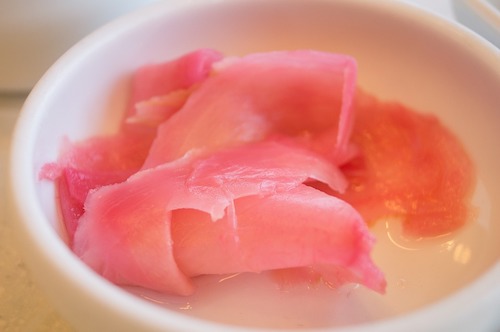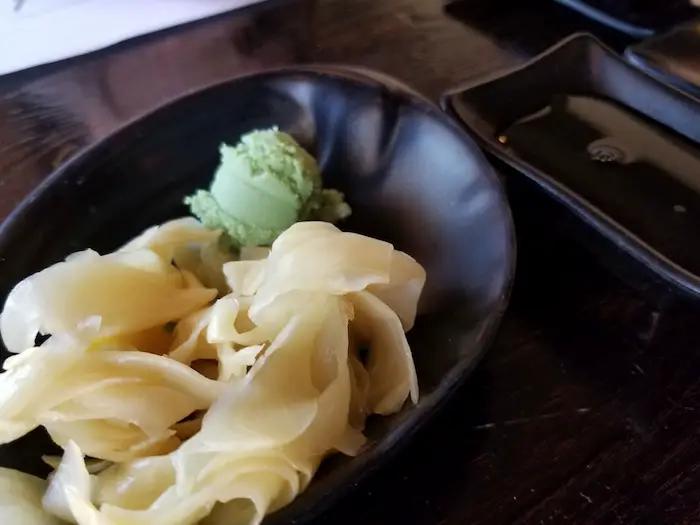We are reader supported. When you purchase through links on our site, we may earn an affiliate commission. Also, as an Amazon affiliate, we earn from qualifying purchases.

When I was first introduced to sushi, the ‘pink ginger’ sitting pretty at the side of the plate fascinated me more than anything else. It was like a custom and almost every sushi bar served the delicious pickled ginger, along with wasabi and soy sauce.
Why is sushi ginger pink? Curious, I looked up on Google to find an answer. Gari (Japanese term for pickled ginger) is made by pickling thin slices of young ginger that has tender flesh and pinkish hue. When pickled with vinegar and sugar, the pink color intensifies to become more prominent. As a result, the gari served with sushi is often called pink ginger.
To make gari, only the freshest and most tender ginger are selected. They have a naturally sweet taste and translucent skin. The tips of the buds may have a pinkish shade. The ginger turns pink within 2-3 minutes of interacting with vinegar solution.
Although we usually relate pickled ginger with pink color, some sushi restaurants may serve white ginger. So, how does the pink ginger turn white and what’s the difference between pink and white ginger. Read on to know more.
Contents
Why Only Young Ginger Is Used For Sushi?
Young ginger used in sushi is different from the matured ginger that is used for cooking. While the former has thin and translucent skin, the later has tough and thick skin. Similarly, young ginger has tender and juicy flesh while the matured ginger is fibrous, tough and veiny.
The young ginger root is harvested and sold in early summer. You can find them at any Asian grocery store selling Chinese and Japanese items. Remember to look for ginger that has pinkish tips due to the coloring pigment that lends a natural pink color to pickled ginger.
The pink hue, however, fades after some time and the pickled ginger turns white. Some restaurants add pink color to the ginger to make them look fresh and presentable.
How Can You Differentiate Between Sushi Ginger And Old Ginger
You can find sushi ginger only during the early summer season while the fully matured ones are available in the market throughout the year.
The young ginger used in making gari has a mild flavor while the mature ones are extremely pungent due to the presence of nonvolatile compounds such as gingerols.
The young ginger buds have a pinkish tint towards the tips, while the old mature ginger usually has a light brown or earthly tone.
The young buds snap easily and the flesh inside looks pulpy and whitish. Old ginger is hard to snap and the inside flesh is usually yellowish in color.
The young gingers used for making gari are mostly thin and tender while the old matured ginger are bulbous and hard to touch.
The outer skin of young sushi ginger is so thin that it does not need any peeling. You can simply rub it off or use a spoon to remove it. Trim the edges, and cut into thin slices to prepare pickled ginger.
Why Do They Add Color To Make Sushi Ginger Pink?
The natural pink color of gari eventually fades to become yellow and then brown in 3 months due to exposure to UV and heat. As a result, commercial sellers often add pink color to retain the hue and make the product more appealing to the customers.
The pinkish hue gives you the notion that the pickled ginger is made from the freshest young ginger of the season. The presentation is an important aspect in sushi culture and the Japanese emphasize on not only the food’s taste but appearance too.
In the restaurants, pickled ginger is usually dyed pink artificially using the E124 cochineal red or beet juice to make them appealing. No wonder the sushi platter looks incomplete without the pink ginger at the side.
Related Article: Why Is Ginger Served With Sushi?
What Is The Connection Between Sushi And Pink Ginger
Whether you pick takeaway sushi from the grocery store or order a California roll at your favorite sushi joint, you will always find some sort of ginger along with your order. It may be tucked neatly in a plastic green grass inside a bento box or served in a small bowl.
Have you ever wondered why at all they serve pink or white ginger slices every time you order sushi? The reason is simple. Given the fact that sushi comprises of a lot of raw seafood, ginger acts as a palate cleanser between different varieties of raw fish.
So, if you start your sushi dinner by eating a spicy tuna roll, it leaves a strong flavor in your mouth. This will prevent you from identifying and relishing the taste of salmon or other seafood that follows.
By chewing a few pieces of gari, you can clean out the flavor and prepare your palate like a clean slate to enjoy the taste of next fish.
What Is The Best Way To Eat Ginger?

As a palate cleanser between nigiri and sushi rolls:
Pickled ginger or gari is traditionally eaten between nigiri and sushi rolls as a way to prepare the palate for next delicacy. In Japan, most chefs don’t serve gari with sashimi because the guests prefer to drink sake or green tea between each bite-size sushi portions. However, if you like eating pickled ginger with sashimi, you may go ahead with that.
See more: Best Drink For Sushi : The Beginner’s Guide
Placed on top of your sushi:
The pink ginger is often placed on top of the sushi containing Saba or Mackerel. Many Japanese prefer to eat pickled ginger with sushi because they enjoy the strong taste of fish combined with the refreshing flavor of Gari.
In western countries, you can often see people putting ginger slices on top of their sushi rolls or nigiri. While there is nothing wrong in doing that, the sushi traditionalists would raise an eyebrow on eating pickled ginger in that way.
According to sushi etiquettes, the pink ginger or gari should not be eaten with the rolls or nigiri. The right method to consume gari is to chew it after eating a complete portion of the sushi roll. This helps in removing the flavor of the previous fish and you are ready to enjoy the next variety.
What Is The Difference Between Pink Ginger and White Ginger

If you ever go to an Asian grocery store to buy sushi ginger (gari) or order it online, you will usually see two different varieties – pink ginger and white ginger. Both the varieties are pickled ginger made from young ginger roots and they are used as a condiment.
When young ginger is pickled, it develops a beautiful pink hue due to the addition of vinegar and sugar. This color usually fades away after some time and the ginger turns white or yellowish in color. In some cases, the slight pink hue may be retained by refrigerating the pickle under 2 degrees.
The white ginger you see in the stores is the pickled version without any added colors. The bright pink ginger you see on the store shelves are not naturally pink. They are dyed using food color or beetroot extracts to develop an attractive hue.
There’s not much difference in taste between pink and white ginger. It’s just the presentation that is different. The pink ginger looks more appealing than the white ginger on a sushi plate.
However, if you prepare pickled ginger at home, you may see a pink tint for a few days but it will eventually turn white or yellowish. That doesn’t mean the pickle has gone bad. It has just lost the color but the taste remains the same.
Related Questions
How to slice young ginger for sushi?
You must make fine slices of ginger using a sharp Japanese knife. They are usually thin enough to fold when pickled. To find the quick recipe to make pickled ginger at home, read this article.
Do you use salt or sugar in sushi ginger?
Pickled sushi ginger is sweet in taste. Sugar is added along with vinegar during the pickling process to enhance the taste of ginger.
Related article: Do Japanese Put Sugar In Green Tea?
How long can the pickled ginger last?
After you open a can of pickled ginger, it should be consumed within three months. If kept in an airtight container inside a refrigerator, it may last for a year or more.
Can you preserve the natural pink color of pickled ginger
If you wish to preserve the natural pinkish color of pickled ginger for a longer time, you will need to refrigerate the product at 2 degrees Celsius. If it is stored away from heat and UV light, the pinkish hue may remain intact for up to one year.

